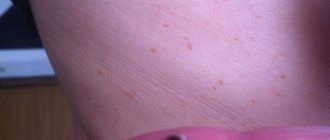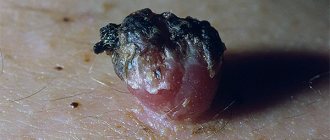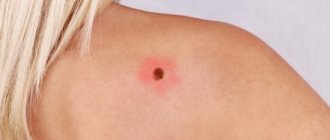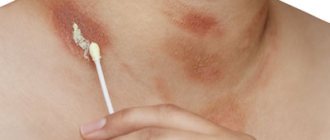Almost every person on the planet has moles (nevi). Exceptions are extremely rare. According to statistics, for every inhabitant of the Earth there are at least 30 moles and age spots on the body. Most often, they do not cause inconvenience, are practically not noticeable and appear only as a speck on our skin. But there are also those nevi that greatly disturb their owners, causing terrible inconvenience. Such formations are protruding nevi located in places that often come into contact with clothing, shoes, etc. This could be the neck, wrist, face, shoulder blades, etc. Damage to such moles can cause serious injury and cause significant damage.
Is mole injury really dangerous?
In RuNet, the danger of traumatizing moles is given excessive, in my opinion, importance. Is there any justification for this point of view? Absolutely, but I think it's quite shaky.
Indeed, there are several studies on this issue, mostly conducted in the 60s–80s of the last century. They show that 30–50% of patients in whom melanoma developed against the background of a nevus noted single or repeated trauma to the mole.
There are several arguments against these studies:
- Just because melanoma develops after trauma to a nevus does not necessarily mean that the two are related. Melanoma could develop both before trauma and much later for other reasons .
- A 2010 meta-analysis (summarizing data from 9 studies) showed that performing an incisional biopsy does not affect the prognosis of melanoma. In other words, if a piece is cut off from melanoma (for diagnostic purposes), this will not negatively affect the patient’s chances of living 5 years or more.
- The conclusions of the authors of several studies (55, 115, 147 and 498 patients) agree on one thing - incomplete removal of nevi, except for dysplastic ones with severe dysplasia, does not lead to the development of melanoma.
Here the corrosive reader will say: “Aha! Still, incomplete removal (you can read “trauma”) causes the development of melanoma!” No. A dysplastic nevus with severe dysplasia itself has a high chance of becoming melanoma in the future. The connection between incomplete removal and the development of melanoma from such nevi has not been proven .
- My experience. Almost every day people write to me who have injured a mole and are now preparing to “die” because they have read too much on the Internet. Almost any person who has a mole protruding above the skin has injured it in one way or another at least once in their life. If trauma to a mole were really a risk factor, in our country with a population of 146,000,000, the diagnosis of melanoma would be made much more often than 8,000 times a year.
First aid
First aid for damage to a nevus is essentially no different from actions for minor scratches and abrasions.
- The first thing to do if you have ripped off a mole is to treat the wound with an antiseptic. It is best to use hydrogen peroxide - it will destroy pathogenic bacteria and stop capillary bleeding. If there is no peroxide in household supplies, then chlorhexidine or miramistin is suitable for disinfecting torn moles. It is allowed to lubricate only the edge of the wound with iodine or brilliant green, without touching its surface.
- If you pick a nevus or scratch it until it bleeds, you may experience prolonged bleeding. Red birthmarks, which contain a large number of blood vessels, bleed especially profusely. To stop such bleeding, it is usually enough to moisten a cotton swab with hydrogen peroxide and press firmly onto the wound for a couple of minutes. If this does not help, you can use a collagen hemostatic sponge or apply a pressure bandage.
- The final stage is the application of a protective cotton-gauze bandage or adhesive plaster. The wound should not be wetted until it heals.
After providing first aid, you need to consult a dermatologist, surgeon or oncologist. They will find out whether the mole poses a threat and tell you what to do next. In most cases, no additional intervention is required.
What will happen to the mole next?
After trauma, as in any other place, the mole will hurt a little and turn slightly red - this is normal. Gradually, after 2-3 weeks, these phenomena should go away on their own. The only situation in which medical intervention may be required is the suppuration of a mole after a severe injury. This means that if after a few days a viscous white (not yellow) liquid begins to come out from the site of injury, you need to be examined by a surgeon. After 1-2 days, a crust will appear at the site of the injury, which will fall off on its own after 1-2 weeks.
Which doctor should I contact?
If a nevus is cut, it is recommended to contact a medical facility as soon as possible; if there was severe bleeding, the blood did not stop well. Treating a wound with antiseptics does not always guarantee that the formation will remain benign and will not degenerate into oncology.
The patient can seek advice from a dermatologist, oncologist or surgeon. Any of the specialists will examine the nevus and prescribe further examinations: dermatoscopy, histology. The doctor will prescribe medication in the form of ointments and creams or send the tumor to be removed.
How to properly monitor a mole after an injury?
To objectively track changes in a mole, after the inflammation has subsided, you can take a photograph of it against the background of a ruler and compare the original image with subsequent ones. In order for the photo to be of high quality and comparison possible, the following rules must be observed:
- The photo must be taken with a camera, not a phone.
- The photo should not be a “selfie”. In such photographs, the mole is usually out of focus.
- A light source or camera flash should be directed at the mole.
Health hazard
Doctors are of the opinion that there is a threat to a person’s health if he accidentally tears off a mole or it comes off.
Many people think that after damage to the pigment spot, a cancerous tumor can develop, that is, from a benign formation, the nevus will degenerate into a malignant one.
However, oncologists have a different point of view. In their opinion, trauma to a mole itself cannot cause cancer.
Although there have been cases in medical practice where, after a nevus ruptures, a person rapidly developed melanoma, doctors are convinced that these people’s birthmarks were cancerous even before the injury. Because of it, irreversible processes in the body accelerated. Doctors advise those who have torn off a mole to be sure to take the torn fragment to the laboratory, where specialists will conduct a histological examination.
Briefly about the main thing:
In my opinion, there is currently no convincing evidence that trauma to a mole can lead to the development of melanoma. Besides me, oncology associations such as NCCN and ESMO also think the same. However, I don’t know if everything was fine with your mole BEFORE the injury. That is why, after the inflammation has subsided, I recommend contacting an oncologist, especially if this specialist has not looked at all of your moles before. If pain, redness, and swelling do not go away within a month, you need to see an oncologist as quickly as possible.
If you still have questions, the following will help you:
- In-person appointment with an oncologist
(St. Petersburg) - Mole removal
with histology (St. Petersburg) - My Online consultation (from anywhere in the world)
Other articles:
- Are moles with jagged edges dangerous?
- Breaking the pattern: 5 myths about mole removal!
- Vital histology
- How to safely remove a mole?
Useful article? Repost on your social network!
Infection and inflammation
If a person has a high immune status, then the addition of a secondary infection or the development of an inflammatory process in the area of the pathological focus is unlikely. But still, an injured mole can give individual symptoms that should alert you and encourage you to seek help from a specialist:
- tingling and burning sensation in the area of the pathological focus;
- slight swelling of the tissues adjacent to the wound;
- hyperemia of the skin around the wound;
- the appearance of itching in the injured area;
- discharge of lymph from the wound.
The appearance of at least one of the listed symptoms should alert the patient and prompt him to seek help from a dermatologist. Early contact with a specialist and a full examination will protect you from serious consequences.
Prevention
To prevent a mole from being torn off, it is important to follow the advice of doctors. The first thing doctors recommend is to monitor the hygiene of your hands and nails. This is one of the principles, since nevi are often injured by nails. You can accidentally comb the formation, scratch it or tear it off. Therefore, hand hygiene should always be carried out thoroughly. There are many bacteria under the nails, due to which microorganisms that provoke inflammatory processes enter the wound formed from tearing off a mole. If you damage a mole with your nails, skin cancer can even develop.
In addition, you need to watch out for clothing, which can tear the nevus. If moles are located in places of increased contact with it, then choose spacious wardrobe items. Clothing should not put pressure on nevi and constantly rub them. In addition, doctors recommend giving preference to those things that are made from natural materials and abandoning synthetic ones.
It is not recommended to use rough washcloths. Instead, it is better to opt for soft and delicate hygiene items. Often moles are injured during the process of bathing, when people subject the skin to excessive massaging with washcloths. It would also be useful to carefully use abrasive products, for example, scrubs. It is recommended not to apply the products to areas of the body where hanging moles are located or where there is an increased accumulation of flat ones. Substances that exfoliate rough skin sometimes injure nevi, causing a number of complications. It is also important to be careful after taking a bath, when wiping the body with a towel, especially when there is a mole that is torn. You should not make too fast or aggressive movements; you need to blot the skin carefully.
Proper removal
When the formation turns out to be benign, the doctor may decide to remove or cauterize its remaining parts. There are several ways to get rid of a mole:
- Using a laser. This method is suitable for eliminating small nevi when the damaged tissue is removed in layers.
- The second method, cryodestruction, involves the use of liquid nitrogen, which freezes the pathological tissue at very low temperatures. In this case, the surface layer of skin dies, a crust forms, and a new skin forms underneath it.
- Another method is called electrocoagulation. As a result of this procedure, they try to cauterize the damaged skin surface using high temperatures and electricity.
- One of the most effective and convenient ways to remove birthmarks is a radio knife. This method is carried out using high-precision equipment. In this case, bleeding is completely eliminated and scars are not formed.
When should a nevus be removed?
Only a doctor determines the degree of importance of removing a nevus, so it is difficult to say unambiguously whether it needs to be removed in a particular case. In addition, most people do not pay attention to moles until they begin to cause discomfort. You need to pay attention if moles have a rich pigment, protrude excessively above the skin or even hang down.
Important! In general, removing moles without good reason is not recommended by doctors. There is an opinion that moles protect a person from the negative effects of the external environment.
You need to examine moles when they are bright in color, occupy a decent area on the skin and are accompanied by increased hair growth. Experts advise removing those moles that are in constant friction and contact with objects. For example, moles on the face of a man who shaves, on the neck, in the waist area or on the lower extremities in the foot area.










